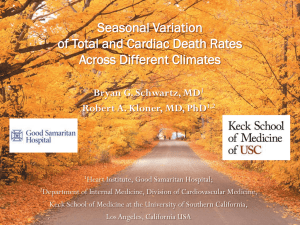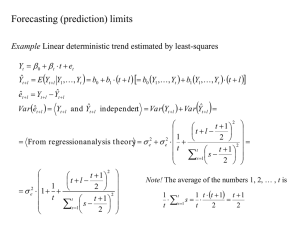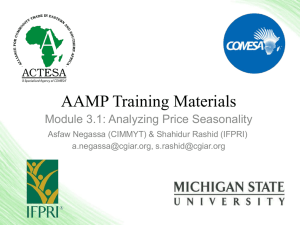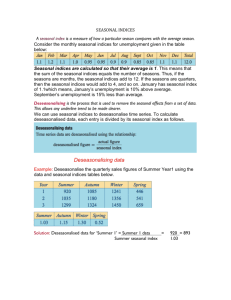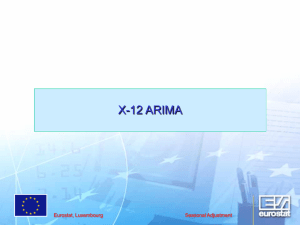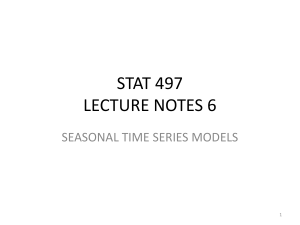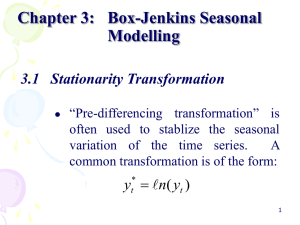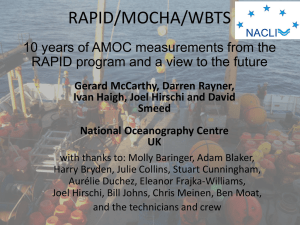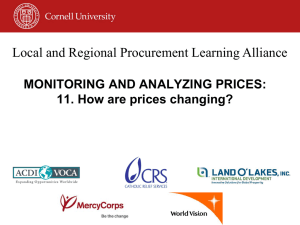Document
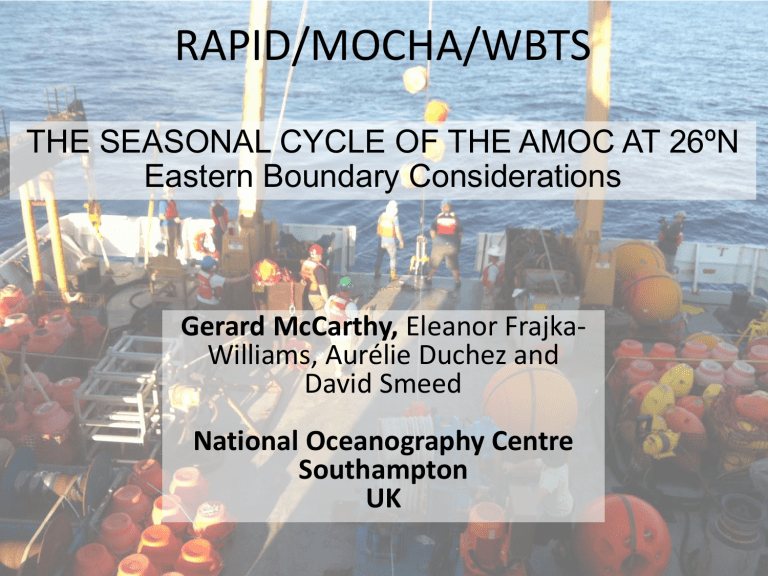
RAPID/MOCHA/WBTS
THE SEASONAL CYCLE OF THE AMOC AT 26ºN
Eastern Boundary Considerations
Gerard McCarthy, Eleanor Frajka-
Williams, Aurélie Duchez and
David Smeed
National Oceanography Centre
Southampton
UK
Introduction
The AMOC at 26ºN
Gulf Stream + Ekman + Upper Mid Ocean = AMOC
Rayner, D., et al. (2011),
Monitoring the Atlantic
Meridional Overturning
Circulation, Deep Sea Research II,
58, 1744–1753.
Gulf Stream, MOC, Ekman & Upper Mid-Ocean Transports
• Interannual Variability in 09/10 shifted circulation from overturning to gyre (McCarthy et al., 2012, GRL)
• Double dips in winters 09/10 and 10/11 described in Blaker et al., 2013, submitted to Climate Dynamics
• AMOC timeseries and related data products are available from www.rapid.ac.uk/rpdmoc
• Data from individual instruments are available from www.bodc.ac.uk
Seasonal Cycle
• Large seasonal cycle in AMOC driven by upper Mid-Ocean transport seasonality
• AMOC timeseries and related data products are available from www.rapid.ac.uk/rpdmoc
Seas. Amp.
GS
3 Sv
MOC
6 Sv
Ekman
3 Sv
UMO
6.5 Sv
Basin-scale Seasonality
The Seasonal Cycle due to the Eastern Boundary
±1.8 Sv,SE=1.0 Sv
SD 3.1 Sv, Range 6.2 Sv
±2.6 Sv, SE=0.5 Sv
Kanzow, T., et al. (2010), Seasonal variability of the Atlantic meridional overturning circulation at 26.5°N, J. Clim.,
23(21), doi: 10.1175/2010JCLI3389.1171.
Chidichimo, M. P., T. Kanzow, S. A.
Cunningham, W. E. Johns, and J. Marotzke
(2010), The contribution of easternboundary density variations to the Atlantic meridional overturning circulation at 26.5
N, Ocean Science, 6,
SD 3.5 Sv,
Range 7.0 Sv
• Largest seasonal influence in mid-ocean transports due to the east
• Recent variability hasn’t changed this
Basinwide response to wind forcing
Seasonal cycle (Sv) in (top) OFES and
(bottom) two layer model • Seasonal cycle coherent across the basin in OFES and simple two layer model
• Not solely an eastern boundary phenomenom and not dependent on location of RAPID moorings
Duchez et al. (2013) Density variations around the
Canary Islands and their influence in the AMOC at
26ºN , in prep
Zhao, J. and Johns, W. E. (2013) Wind driven seasonal cycle of the Atlantic Meridional Overturning
Circulation, submitted
70ºW 60ºW 50ºW 40ºW 30ºW 20ºW
Forced Rossby wave response to wind stress curl
• Ocean response to wind stress curl forced Rossby wave model explains the first baroclinic mode structure seen in observations
Modelled Mid-ocean transport anomaly Observed Mid-ocean transport anomaly
Local Seasonality
Local Seasonality
• Not all of seasonal structure explained by first baroclinic mode structure
Observed Mid-ocean transport anomaly
Canarian Deep Poleward Undercurrent
Vélez-Belchi, P., et al. (2013), The
Canary deep poleward undercurrent. In prep
Machín, F., et al. (2009), Northward
Penetration of Antarctic Intermediate
Water off Northwest Africa, JPO, 39,
512-535
• AAIW (MOW) flows northward (southward) in the Canarian deep poleward undercurrent
(CDPU)during the
Autumn (Spring) forced by seasonal layer stretching (compression)
• This deep poleward undercurrent is unusual and infrequently observed
Seasonal Reversals of Intermediate Water
• Distinct seasonal reversals of flow in the
Lanzarote Channel
• Intermediate (1000 m) measurements correlate salinity changes with current reversals
• High salinity Med.
Outflow water (MOW):
Southward flow in
Dec/Jan
• Low salinity Antarctic
Int. Water (AAIW):
Northward flow in
Summer/Autumn
Machín, F., et al. (2010), Seasonal Flow
Reversals of Intermediate Waters in the
Canary Current System East of the
Canary Islands, JPO, 40, 1902–1909
Evidence of CDPU in RAPID mooring data
Monthly Sal. Anom on 8 C
500 dbar
1000 dbar
2000 dbar
• Rapid data at Eastern Boundary shows clear salinity signal of seasonal oscillations around 1000 dbar
• These are consistent with seasonal reversals of AAIW and MOW in the CDPU
Evidence of layer stretching
Large Scale Consequences
• Understanding the role of the Poleward Undercurrent is important to understand the part of the seasonal cycle that is not explained by the Rossby Wave model
• It has important consequences for freshwater transport at 26 N as transport fluctuations are associated with salinity changes
• Changes in freshwater flux near the eastern boundary of 0.1 Sv are not picked up by models
Observed Mid-ocean transport anomaly
Integrated Freshwater flux at 26ºN
Courtesy of Elaine McDonagh
Conclusions
• MOC seasonal cycle is 6.7 Sv peak-to-peak
• UMO contributes the most pronounced seasonal cycle of 5.9 Sv
• Seasonal cycle in UMO is caused by heaving of the thermocline forced by seasonal anomalies in the wind stress curl.
• Canarian deep poleward undercurrent plays a secondary role driven by seasonal stretching of the intermediate layer
End
Contribution of the upper mid-ocean western and eastern boundaries to the UMO seasonal cycle
Expectation that upwelling drives stronger (weaker) thermocline flow in the autumn (spring)
Reality is that seasonally reversing intermediate flows driven by water column stretching (squeezing) are the major factor
Chidichimo, M. P. et al.,(2010),
The contribution of easternboundary density variations to the Atlantic meridional overturning circulation at 26.5
N, Ocean Science, 6
The research leading to these results has received funding from the European Union
7th Framework Programme (FP7 2007-2013), under grant agreement n.308299
NACLIM http://www.naclim.eu

